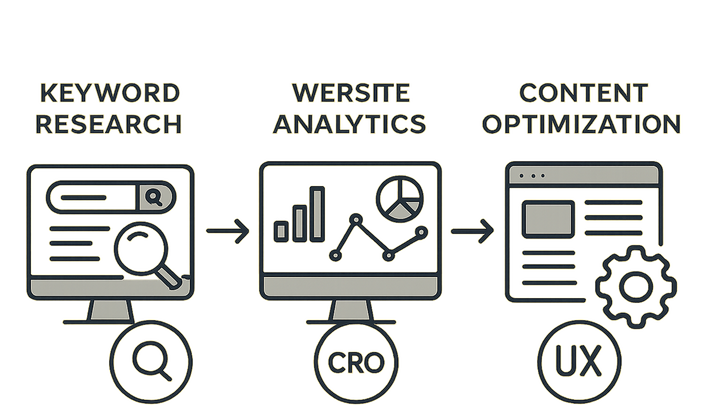Published on 2025-06-29T21:08:52Z
What is Keyword Optimization? Examples for SEO, CRO & UX
In the realms of SEO, CRO, and UX, Keyword Optimization is the process of researching, selecting, and strategically placing keywords throughout your website to align with user search intent. Effective Keyword Optimization ensures your content reaches the right audience, improves your search engine rankings, and enhances on-page user experience. Beyond just inserting keywords, it involves understanding search volume, competition, and relevance to drive qualified traffic and maximize conversions.
By optimizing keywords, you can:
- Increase organic visibility and click-through rates
- Align content with user expectations and intent
- Boost lead generation by targeting high-intent queries
- Inform content structure for a seamless user journey
Tools like Prevue.me, Ahrefs, and SEMrush can provide actionable insights into keyword performance and guide continuous optimization efforts.
Keyword optimization
Keyword Optimization involves researching and placing the right keywords to boost organic visibility, improve UX, and drive conversions.
Why Keyword Optimization Matters
Keyword Optimization is a cornerstone of SEO, UX, and CRO strategies. By aligning your content with user intent, you ensure that searchers find relevant information quickly, stay engaged, and are more likely to convert.
-
Improving search visibility
Selecting and placing high-value keywords helps search engines understand your content and rank it for relevant queries.
- Search intent alignment:
Choose keywords that match the informational, navigational, or transactional intent of your audience.
- Competition analysis:
Evaluate keyword difficulty to focus on terms with attainable ranking potential.
- Search intent alignment:
-
Enhancing user experience
When content mirrors the language and needs of your users, they find answers faster and interact more deeply with your site.
- Relevant content:
Integrate keywords naturally within headings, body text, and metadata to guide users.
- Clear navigation:
Use optimized anchor text and labels to help users and crawlers navigate your site.
- Relevant content:
-
Driving conversion rates
Targeting high-intent keywords—especially long-tail phrases—attracts users ready to take action, increasing lead generation and sales.
- Transactional keywords:
Focus on terms like “buy,” “sign up,” or “demo” for conversion-driven pages.
- Call-to-action placement:
Include keywords in CTAs to reinforce the next step in the customer journey.
- Transactional keywords:
Key Components of Keyword Optimization
Effective Keyword Optimization combines thorough research, strategic placement, and ongoing monitoring to maintain and improve performance over time.
-
Keyword research
Identify relevant keywords by analyzing search volume, competition, and user intent using tools like prevue.me, Ahrefs, or SEMrush.
- Search volume:
Measure monthly search queries to gauge potential traffic.
- Keyword difficulty:
Assess ranking competitiveness to prioritize opportunities.
- Search volume:
-
Keyword mapping & placement
Assign target keywords to specific pages and integrate them into strategic locations.
- Title tags & meta descriptions:
Include primary keywords to improve click-through rates.
- Headings & body text:
Use keywords in H1/H2 tags and naturally within paragraphs.
- Image alt text & urls:
Optimize non-text elements and permalinks with relevant terms.
- Title tags & meta descriptions:
-
Monitoring & adjustment
Track keyword rankings and performance metrics to refine your strategy over time.
- Rank tracking:
Use prevue.me or Google Search Console to monitor position changes.
- Traffic analysis:
Analyze organic traffic trends and user behavior in Google Analytics.
- Rank tracking:
Implementing Keyword Optimization with Prevue.me
prevue.me offers integrated SEO and CRO audits, delivering actionable keyword insights to boost lead generation and user engagement.
-
Quick audit
Scan your site to identify missing or underperforming keywords and metadata.
- Seo audit report:
Provides a keyword-focused breakdown of page strength and weaknesses.
- Seo audit report:
-
Actionable recommendations
Receive prioritized suggestions for keyword targeting and on-page optimization.
- Content improvements:
Get specific advice on where to insert or replace keywords for better relevance.
- Content improvements:
-
Tracking impact
Monitor how implemented changes influence rankings and conversion metrics over time.
- Dashboard insights:
Visualize keyword performance and lead-generation impact in one place.
- Dashboard insights:
Best Practices and Common Pitfalls
Adhering to SEO and UX best practices prevents over-optimization and ensures sustainable growth.
-
Avoid keyword stuffing
Overloading pages with keywords can harm readability and incur search engine penalties.
- Natural language:
Write for humans first, then optimize for search engines.
- Natural language:
-
Balance short and long-tail keywords
Mix high-volume head terms with specific long-tail phrases to capture diverse traffic.
- Comprehensive coverage:
Use topic clustering to cover all related queries and intents.
- Comprehensive coverage:
-
Regularly refresh your keywords
Search trends evolve, so update your target list to stay competitive.
- Seasonal adjustments:
Optimize for trending or seasonal terms as needed.
- Seasonal adjustments:
